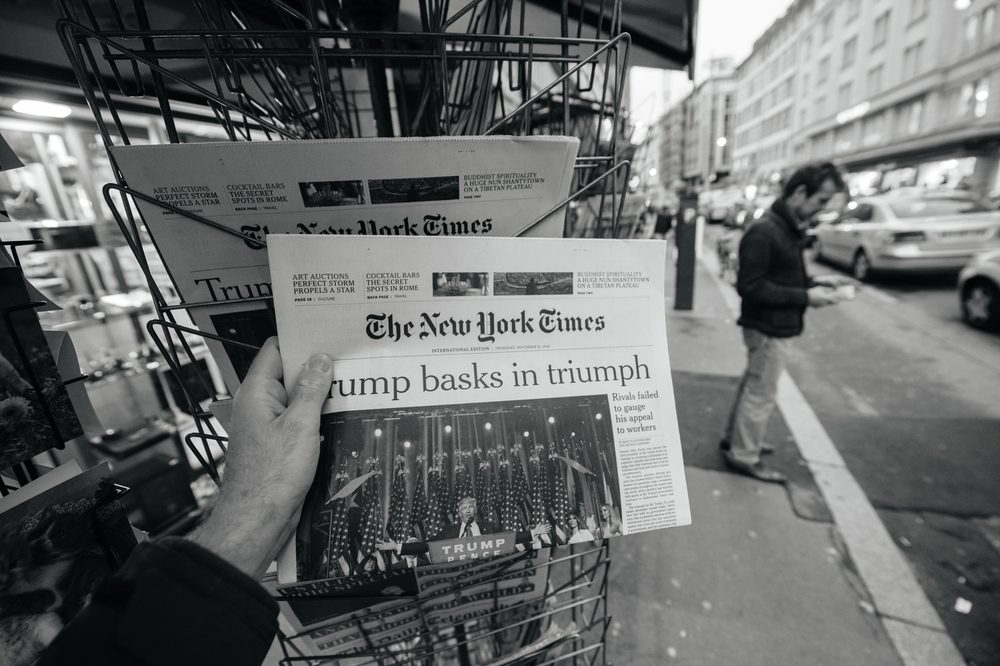The New York Times: The World’s Longest Church Bulletin

I have, for years now, read the New York Times, and for the most part unironically. For all its dowdy Manhattan leftism and paint-by-numbers Blairist opinion writing, the Times has remained a bulwark of old-fashioned newspaper journalism, its pages thick, its interests wide-ranging, its reading level higher than the usual magnetic letters on the fifth-grade fridge. I don’t live in New York and never plan to, but that kind of thing is difficult to find.
For what it’s worth, even Tucker Carlson used to agree. The Times, he said at CPAC 11 years ago, “actually cares about accuracy” and should serve as a model for conservative news startups. (That got him jeered by the audience of right-wing activists.)
So what, then, are we to make of today’s New York Times? Whatever bias once existed there, whatever gentle tug to the left you felt while reading it, has now mushroomed into ridiculous agitprop. This isn’t just about the opinion page, which shoved out editor James Bennet earlier this summer for the crime of publishing an op-ed by a Republican senator. It’s an embedded tendency towards a singular way of thinking that’s seemingly affected all strata of the newspaper.
The Times is now a place that, after months of violent protests in Portland—really years; rioters have been raging there since Trump’s election—sends a tweet that reads: “As right-wing groups increasingly move to confront protesters in U.S. cities, demonstrators are assessing how to keep themselves safe.” (“Keep themselves safe”—a Trump supporter had just been shot and killed!) It’s a place that ran an insanely tendentious piece accusing the mostly upbeat night one of the Republican National Convention of having an “ominous tone” and attempting to “rewrite history.”
It’s a place that, just four days ago, published a “profile” of Andrew Sullivan that was less shoe leather than bell, book, and candle. The piece, slugged “I’m Still Reading Andrew Sullivan. But I Can’t Defend Him,” reached deep into its bag of journalistic prisms and came back with this utterly novel and insightful analysis: Sullivan is a racist. It was a tough thesis to defend, given that, as the article noted, Sullivan had endorsed Barack Obama and was one of the former president’s favorite writers. The profile author, Ben Smith, mustered up three charges. First and foremost, all the way back in 1994, Sullivan had published a symposium at the New Republic about The Bell Curve, a book that alleged differences in IQ between the races. (Smith actually called that Sullivan’s “original sin.”) Second, he’d once sent a puckish and apparently drunken email to an author on the Times‘ 1619 Project. Third, he’d mused that it was interesting that a lot of Jews had won the Nobel Prize.
From here, there could be only one conclusion: “His career, with all its sweep and innovation, can’t ever quite escape that 1994 magazine cover.”
I wasn’t able to read further, as the rest of the piece was in Latin chant.
That Smith’s essay feels more like an excommunication hints at the changes happening at the Times and on the left more generally. Once, the bias over there was incidental, even intellectual, the result of shared assumptions among a largely New York-based staff and perhaps a mild activist impulse to convert. Sam Tanenhaus, for example, has gotten much wrong (sometimes egregiously wrong) about conservatism, but he at least seems curious about his subject matter, even if his biases do refract his findings in a certain direction. Whereas the current coverage is interested primarily in liturgy, in reciting the same lines from the same preconceived assumptions. Of course Sullivan must be reduced to racism: that’s what the post-1619 Times does, just as Portland must become a story about knuckle-dragging violent right-wingers. Question these methods, as Bari Weiss, a former Times columnist, often did, and you get mercilessly bullied by the villagers, given the apostate’s treatment.
The thing about liturgy is that, unless you believe in the religion, it quickly grows boring. You know what’s going to be said; the entire point is that you mouth along. So it goes at the Times today. Some conservatives will reply that it’s been like this for a while, that I’ve been whistling past the graveyard. But I don’t think so. I agree with Carlson: a decade ago, even two years ago, the Times was a better and fairer newspaper. There are still glimmers of that today: in an excellent portrait of post-Freddie Gray Baltimore, in a wonderful profile of kleptocratic Iraq. But generally speaking, the Times now reads like the world’s longest church bulletin. That’s a shame.
Comments